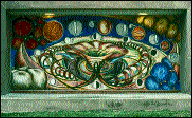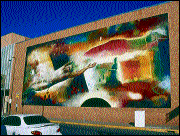
The Multiple Faces of BIG Wall ArtMurals, frescoes, petroglyphs and more bedeck our outdoor walls. |
 Image: ©2000 Frederico Vigil |
Animated by flickering torches the rhinos, bulls, deer, bison and horses came alive in the imaginations of initiates as they stared in awe at the walls of Chauvet Cave in France 30,000 years ago. We assume that shamanic legends of the hunt and explanations of animal spirits were described in front of those most ancient forms of wall art yet discovered. Only half as old and more sophisticated are the wall and ceiling paintings in the caves at Lascaux, France and the Los Toldos Cave in Argentina. To enter those ancient earthly wombs was a form of rebirth and transformation for participants. Human beings evolved animist- inspired wall art into both portable and permanent forms that told stories, offered windows onto the world, reached the depths of the unconscious or passed religious iconography from one generation to the next. |
The great halls of Europe were decorated with battle commemorations, coronations and religious themes. Following centuries of panel and canvas painting, American painter Jackson Pollock threw large unstretched canvases on the floor to expand his visual field and allow him to pour, spatter and drip color from above. Contemporary film and video bring animated adventure, information and cheap thrills to audiences who sit in the dark staring at a flat wall that is covered with illusions of depth and motion that attach themselves to the imagination just like those torch lit images in Chauvet Cave. Wall art includes fresco, easel painting, tapestry, bas relief sculpture, spray can graffiti, prints, photographs, petroglyphs, pictographs, mosaics, movies, wall paper, and inexpensive poster art. Wall art brings to us Michelangelo's religious treatise on the ceiling of the Sistine Chapel, the abstract patterning of an Islamic Mosque, political statements by Francisco Goya, murals in Egyptian temples and the opulent high culture frescos of ill fated Pompeii. The fresco technique of painting on wet plaster is the most permanent type of wall art yet developed. The ancient Anasazi used a similar technique to embellish the walls of their Chaco Canyon Pueblos and other sacred sites. They apparently learned their methods from the Aztecs, Toltecs and Mayans. During the early 20th century Mexican muralists José Clemente Orozco, José Diego Maria Rivera and David Alfaro Siqueiros reestablished fresco painting in the Americas. Internationally-acclaimed Santa Fe artist Frederico Vigil uses fresco painting to keep traditional Hispanic cultural values alive. His work at the New Mexico Museum of Fine Arts in Santa Fe commemorates the Cuatro Centenario celebration of 400 years of Spanish settlement in New Mexico. Vigil also has frescos at The Albuquerque Museum, the College of Santa Fe and other major institutions. "Frederico Vigil is particularly important because he is a homegrown New Mexican who has grown far beyond the geographic boundaries of the area," Spanish Colonial Arts Society Museum director Stuart Ashman said. Vigil pursues fresco painting because of its permanence and its connection to New Mexico's history. "The ancient Indians knew how to paint frescos before the Spanish came but they forgot how to do it. When Diego Rivera and other Mexican artists wanted to learn fresco painting they had to study in Italy," Vigil said. Vigil learned the painstaking technique from Stephen Dimitroff who was Rivera's lead assistant fresco artist. |
Murals are a form of wall art that can be executed at one location and installed in another. Albuquerque landscape muralist Wilson Hurley has developed a technique of painting large canvases on a system of rollers. He sees his work in segments like a Chinese scroll painter. "Traditionally, painting is an attempt to communicate intellectually and emotionally to a viewer. Years ago when I announced my intention to be a representational artist some people treated me as if I'd soiled my trousers in church," Hurley said. The battle between representational and non-representational art was fought on the walls of galleries and museums for more than 150 years with a plethora of art movements beginning with impressionism and ending with post modernist deconstruction. Public murals reflect political propaganda, cultural ideals and historical events such as the Great Depression. During the 1960s, mural-scale outlaw graffiti and tagger signatures covered subway cars and public walls in New York, Los Angeles and Chicago. The underground expression of disenfranchised youth spread across the land quickly descending from art to vandalism. |
 Image: ©2000 |
|
To illustrate the broad range of wall art, we can compare Pablo Picasso's 1937 "Guernica", decrying the brutality of experimental modern warfare, to a vapid flirtation depicted in Jean Honoré Fragonard's 1767 "The Swing". Graffiti artists who were willing to work on canvas were given shows at major galleries. Los Angeles artists Judy Baca and Isabel Castro designed the "Great Wall of Los Angeles", a fourteen-foot-high by one-half-mile-long mural in 1976. Baca went on to found the Social and Public Art Resource Center that encourages gang members, graffiti artists and middle class people to join together as teams to produce legitimate murals throughout Los Angeles. The Viet Nam Veterans Memorial in Washington D.C. designed by Maya Lin is a polished black marble wall covered with the names of more than 50,000 soldiers who died in the war. Though controversial when built 20 years ago, Lin's wall art has become a permanent and deeply-revered part of America's cultural heritage. In 2000, Albuquerque Mayor Jim Baca's Art Summer Institute commissioned mentor artists Kevin Zuckerman, Kathleen Sweeney, Rachel Popowcer, Mathew Lutz and 16 apprentices to paint the "Echoes of the Future" mural at Second Street and Central Avenue NW in downtown Albuquerque. Their two-story-high, one-half-block-long acrylic mural blends ideas from art history, several cultures and contemporary science in order to imagine beyond the present moment. Critic and curator Dave Hickey said that all wall artists are territorial taggers, including Michelangelo. Hickey included graffiti in the Beau Monde: Toward a New Cosmopolitanism, a biennial exhibition which ran July 2001-January 2002 at SITE Santa Fe. Wall art reflecting shifts in human consciousness about what constitutes a beautiful world continues to fill galleries, museums and collectors' homes. Contemporary New Mexico easel artists Susan Rothenberg and Jaune Quick-to-See Smith browse art history to pluck animistic imagery from the cliff walls and caves of antiquity while John Rise and Robert Peterson replicate nineteenth-century-style still life subjects, and Michael Hart and Emily Trovillion manifest surrealistic fantasies. Flat screen television, holographic images, digital collage and the Internet may change how we view wall art, but our intolerance for blank walls should keep artists forever busy in every medium and style. |
|
Thanks to Wesley Pulkka who reports on and reviews the arts regularly in Originally appeared in |
Collector’s Resources |
|
RESOURCE LISTS UPDATED WHEN VIEWED | ARTICLE CONTENT REVISED October 14, 2009 |